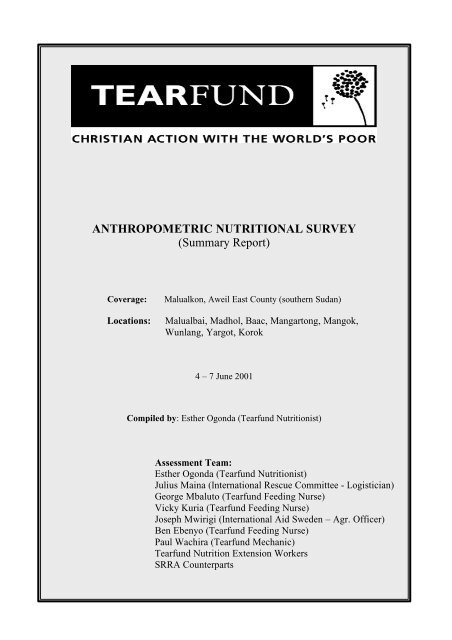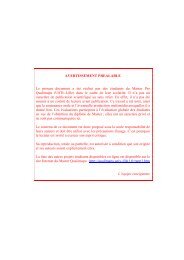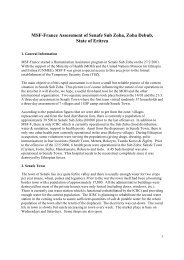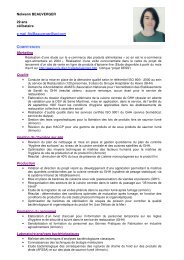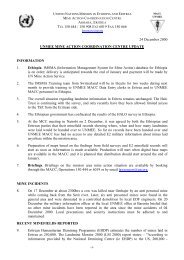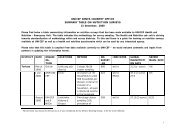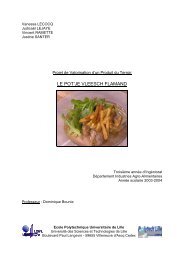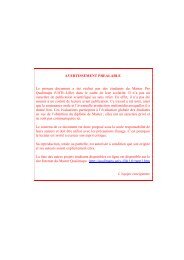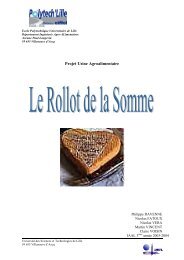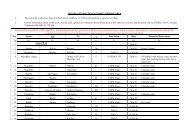ANTHROPOMETRIC NUTRITIONAL SURVEY - PFEDA / Page d ...
ANTHROPOMETRIC NUTRITIONAL SURVEY - PFEDA / Page d ...
ANTHROPOMETRIC NUTRITIONAL SURVEY - PFEDA / Page d ...
Create successful ePaper yourself
Turn your PDF publications into a flip-book with our unique Google optimized e-Paper software.
<strong>ANTHROPOMETRIC</strong> <strong>NUTRITIONAL</strong> <strong>SURVEY</strong><br />
(Summary Report)<br />
Coverage: Malualkon, Aweil East County (southern Sudan)<br />
Locations: Malualbai, Madhol, Baac, Mangartong, Mangok,<br />
Wunlang, Yargot, Korok<br />
4 – 7 June 2001<br />
Compiled by: Esther Ogonda (Tearfund Nutritionist)<br />
Assessment Team:<br />
Esther Ogonda (Tearfund Nutritionist)<br />
Julius Maina (International Rescue Committee - Logistician)<br />
George Mbaluto (Tearfund Feeding Nurse)<br />
Vicky Kuria (Tearfund Feeding Nurse)<br />
Joseph Mwirigi (International Aid Sweden – Agr. Officer)<br />
Ben Ebenyo (Tearfund Feeding Nurse)<br />
Paul Wachira (Tearfund Mechanic)<br />
Tearfund Nutrition Extension Workers<br />
SRRA Counterparts
NUTRITION <strong>SURVEY</strong> SUMMARY REPORT FOR AWEIL EAST COUNTY<br />
Date of the survey: 4 th –7 th June 2001<br />
BAHR-EL GHAZAL REGION – JUNE 2001<br />
Area of the coverage: Eight payams: Madhol , Mangok , Malualbai, Yargot, Baac, Wunlang ,<br />
Korok , Mangar tong.<br />
Methodology: Two –stage cluster sampling method (30 clusters of 30 children).<br />
Semi structured interview schedules were used to collect the data and all the<br />
enumerators and team leaders attended the half day training session prior to<br />
the survey.<br />
Targeted Group: Children 6-59 months in age (65-115 cm in height)<br />
Sample size: 895 Children<br />
Objectives<br />
• To assess the nutritional status of children aged between 6-59 Months in Aweil East County Bahrel<br />
Ghazal region.<br />
• To determine the various food sources used during the current hunger gap period.<br />
• To estimate the proportion of displaced persons that have arrived within the community over the<br />
last 7 months and to estimate their nutritional status.<br />
RESULTS INDICATOR<br />
Population assessed: 936<br />
Population analysed: 895<br />
Total number of households analysed: 565<br />
Nutritional status of children between 6-59 months<br />
Global acute malnutrition rate (
MALNUTRITION RATES PER PAYAM<br />
Payam No. of children assessed Proportion malnourished<br />
Madhol 30 46.7%<br />
Mangok 30 33.3%<br />
Malualbai 33 27.3%<br />
Yargot 90 38.8%<br />
Baac 121 32.2%<br />
Wunlang 173 28.9%<br />
Korok 185 24.8%<br />
Mangar-Tong 233 24.0%<br />
FOOD SOURCE Propotion of dependency<br />
WFP 63.6%<br />
Trade 13.7%<br />
Wild plants and indigenous foods 77.6%<br />
Cultivation 21.8%<br />
Kinship sharing 14.7%<br />
Livestock 6.0%<br />
Population movements<br />
Percentage of displaced persons 16.6%<br />
Percentage of returnees 6.7%<br />
Percentage of residents 76.7%<br />
Discussion<br />
The survey was carried out in the hunger gap period – a time characterised by increased starvation as a<br />
result of the low food baskets available to the population, which has been compounded by continued<br />
insecurity which has affected the planting season. The situation was further aggravated by the poor<br />
previous harvest due to insufficient rains.<br />
The results indicate a very high global acute malnutrition rate of 28.9% z scores (CI 95% 24.9% -<br />
32.9%). Comparing these levels with the last survey in March 2001 which recorded a malnutrition rate<br />
of 15.5% (z scores) the situation is evidently becoming more alarming and may reach crisis conditions<br />
should insecurity cause large scale displacement into the region. Tearfund recorded a global acute<br />
level of 36.2% (z scores) and 12.1% severe in Aweil East during the height of the 1998 famine.<br />
A severe malnutrition rate of 5.5% (z scores) was recorded in this present survey. This figure has<br />
increased from the last recorded levels of 1.8% (z scores) in March mainly as a result of the now empty<br />
food baskets at the household level (buried food has now been dug up and eaten). It is also important to<br />
note that the children in the age bracket of 6-24 months are again the most affected category primarily<br />
as a result of weaning practices. These figures portray a serious condition at this stage of the hunger<br />
gap with over two months to go before the advent of the first ground nut harvest.<br />
The results also indicate that most of the population (77.6%) depend on indigenous foods and wild<br />
plants as their main source of food. A relatively high percentage (63.6%) of the people also rely on the<br />
WFP general ration. The remaining 36.4% of the population does not have access to this intervention<br />
and can be said to be insecure in terms of food security and as a result stand a higher risk of a rapid<br />
deterioration in their nutritional status.<br />
3
Most of the population assessed did not have livestock on the ground, leaving more than 90% of the<br />
people with no access to milk or any form of meat foods. 13.7% of people surveyed were involved in<br />
various forms of trade, enabling them to cope to some degree with the current food insecurity.<br />
RECOMMENDATIONS<br />
Nutrition<br />
• It is essential that the mobile supplementary feeding programme is continued to prevent a general<br />
deterioration in the situation with many more children becoming severely malnourished.<br />
• Extensive household visits should be carried out by the nutrition extension workers to increase the<br />
coverage of the supplementary feeding beneficiaries. Those eligible for the therapeutic feeding<br />
centre should be given the opportunity to enroll into the programme.<br />
• It will be important to conduct a follow up nutritional survey in the location preferably after a 4<br />
month period so as to evaluate the impact of the on going interventions. Tearfund should also carry<br />
out more longitudinal surveying across a smaller number of households in each supplementary<br />
feeding site per week. This will enable nutrition extension workers to gain a micro understanding<br />
of changing food and health patterns rather then sporadic nutritional snapshots.<br />
• Health education, nutrition and food security lessons should be conducted alongside the feeding<br />
sessions to ensure that the chronic situation in the location is addressed in the long run.<br />
• Tearfund should continue to work closely with the International Rescue Committee (IRC) and<br />
other INGO’s in Malualkon to co-ordinate health, nutrition and food security programming.<br />
Food security<br />
• The general food distribution ration (WFP) needs to be increased from the current 50% to 75%<br />
particularly during this phase of the hunger gap to enable the beneficiaries to be able to meet their<br />
nutritional needs.<br />
• A more targeted intervention aiming at increasing the food basket of the currently affected people<br />
(the beneficiaries at the feeding centres) should be put into place so as to hasten their recovery rate.<br />
4


